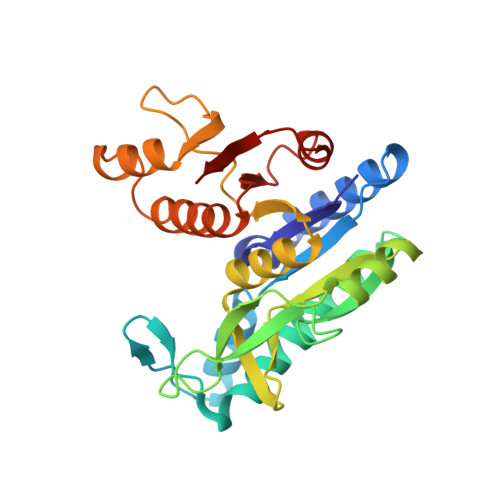Two Crystal Structures of Escherichia Coli N-Acetyl-L-Glutamate Kinase Demonstrate the Cycling between Open and Closed Conformations.
Gil-Ortiz, F., Ramon-Maiques, S., Fernandez-Murga, M.L., Fita, I., Rubio, V.(2010) J Mol Biol 399: 476
- PubMed: 20403363
- DOI: https://doi.org/10.1016/j.jmb.2010.04.025
- Primary Citation of Related Structures:
2WXB, 2X2W - PubMed Abstract:
N-Acetyl-L-glutamate kinase (NAGK), the paradigm enzyme of the amino acid kinase family, catalyzes the second step of arginine biosynthesis. Although substrate binding and catalysis were clarified by the determination of four crystal structures of the homodimeric Escherichia coli enzyme (EcNAGK), we now determine 2 A resolution crystal structures of EcNAGK free from substrates or complexed with the product N-acetyl-L-glutamyl-5-phosphate (NAGP) and with sulfate, which reveal a novel, very open NAGK conformation to which substrates would associate and from which products would dissociate. In this conformation, the C-domain, which hosts most of the nucleotide site, rotates approximately 24 degrees -28 degrees away from the N-domain, which hosts the acetylglutamate site, whereas the empty ATP site also exhibits some changes. One sulfate is found binding in the region where the beta-phosphate of ATP normally binds, suggesting that ATP is first anchored to the beta-phosphate site, before perfect binding by induced fit, triggering the shift to the closed conformation. In contrast, the acetylglutamate site is always well formed, although its beta-hairpin lid is found here to be mobile, being closed only in the subunit of the EcNAGK-NAGP complex that binds NAGP most strongly. Lid closure appears to increase the affinity for acetylglutamate/NAGP and to stabilize the closed enzyme conformation via lid-C-domain contacts. Our finding of NAGP bound to the open conformation confirms that this product dissociates from the open enzyme form and allows reconstruction of the active center in the ternary complex with both products, delineating the final steps of the reaction, which is shown here by site-directed mutagenesis to involve centrally the invariant residue Gly11.
Organizational Affiliation:
Instituto de Biomedicina de Valencia-Consejo Superior de Investigaciones Científicas and Centro de Investigación Biomédica en Red de Enfermedades Raras (CIBERER-ISCIII), Jaime Roig 11, Valencia 46010, Spain.

















